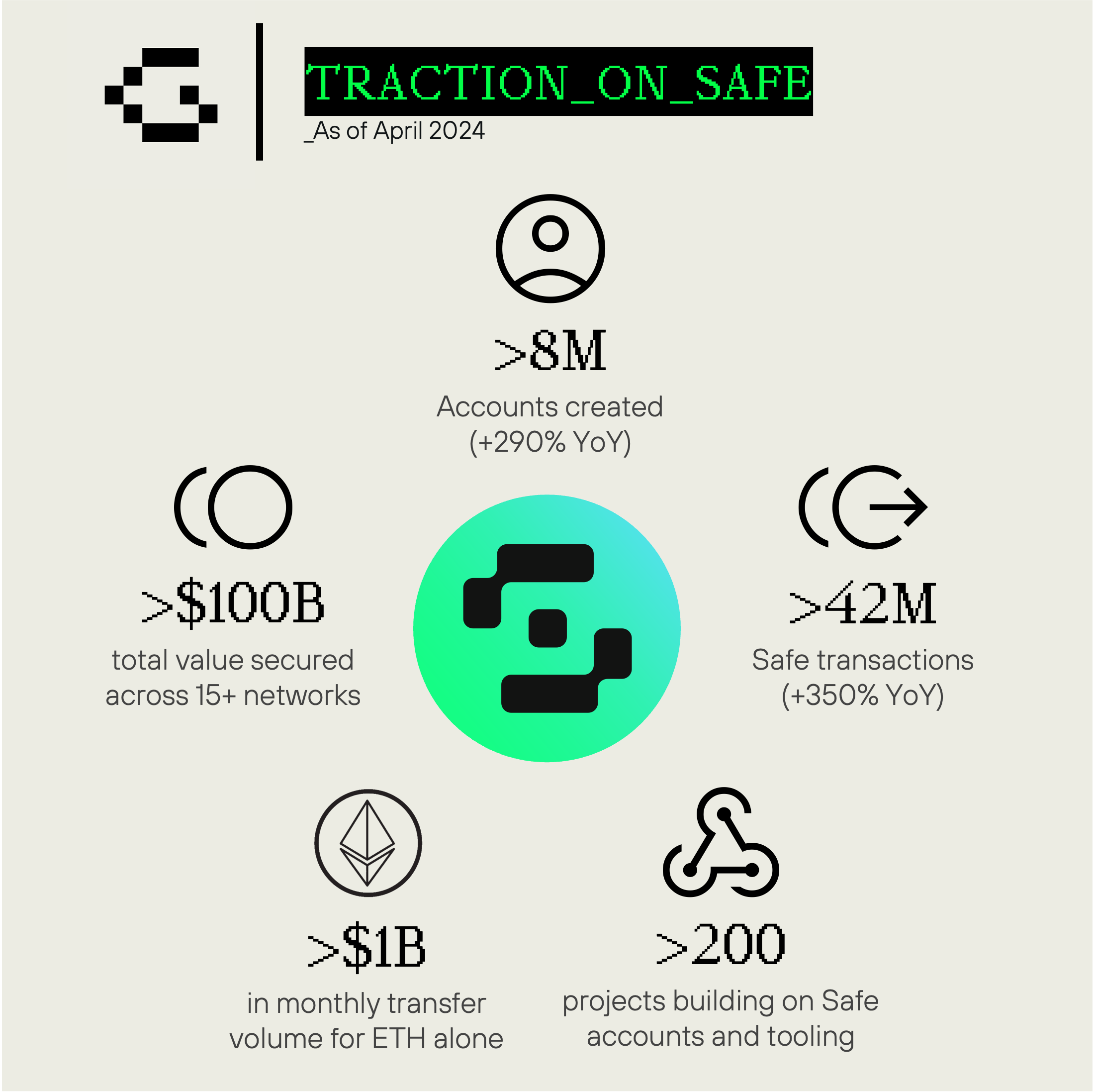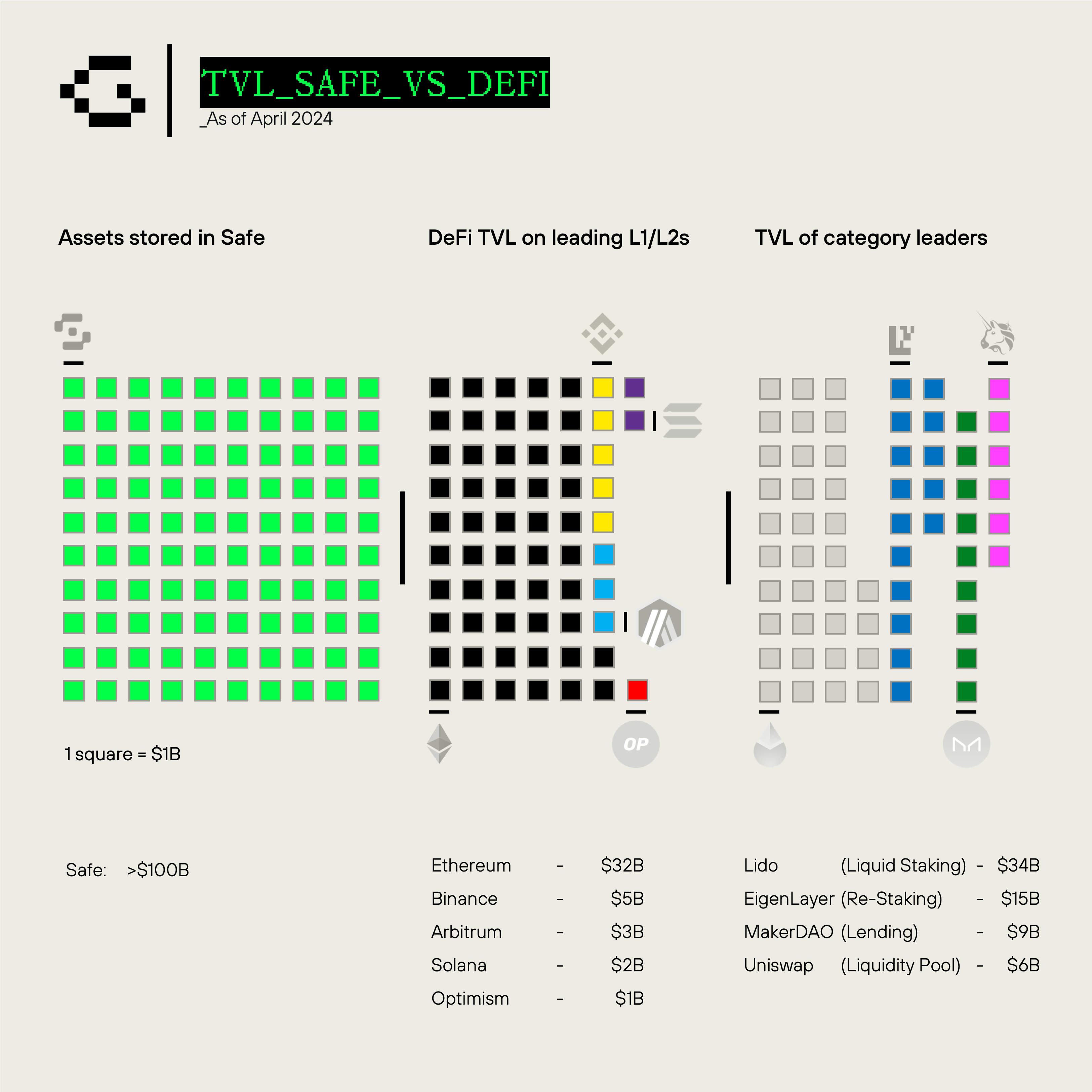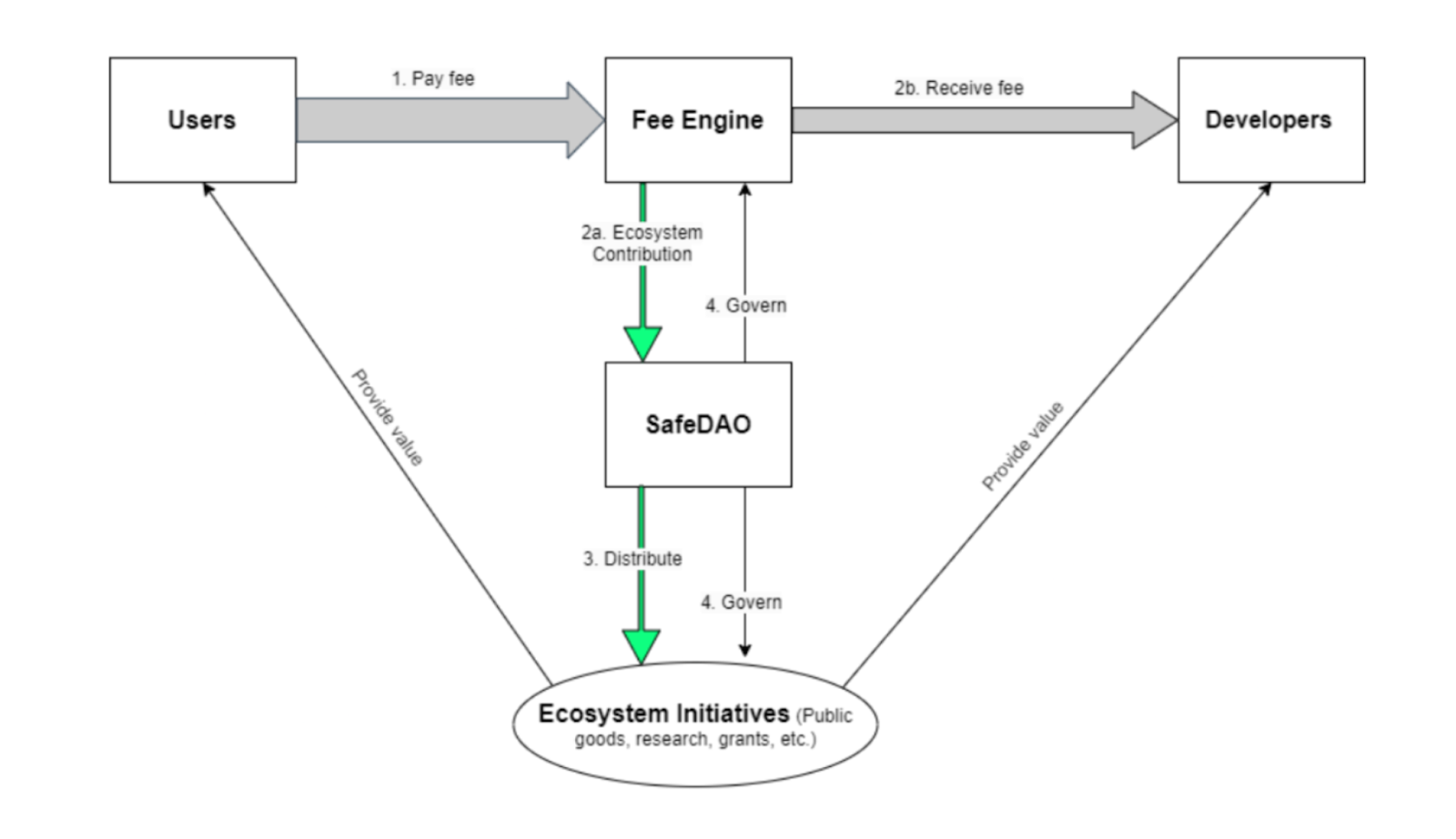Building The Industry Standard For Programmable Digital Ownership with Safe
by Felix Machart – Apr 24, 2024
Since 2022, we have been backing Safe (rebranded “Gnosis Safe”). Meanwhile, the smart contract wallet platform has emerged as critical infrastructure and the most used industry standard for securely managing digital assets in web3. Safe has achieved wide adoption, securing over $100B in assets and being used by major DAOs, institutions, and individuals. This article reiterates our initial investment thesis and showcases our continued conviction in the project, while arguing that Safe features elements of a meta aggregator for web3, putting it in a dominant strategic position.
With the “Building_” series, we pay tribute to Greenfield portfolio companies recently achieving a significant milestone or breakthrough, contributing to an open, decentralized, and more robust architecture for tomorrow’s web.
At Greenfield, we have been funding cryptonetworks and projects building on top of them with a vision toward the emerging internet of programmable value, data and identity. We believe several attributes make such a system well-positioned for massive growth, innovation and resilience:
- Internet-native digital property rights enforced at the base-layer (the strength of property rights is one of the most important determinants of success of economies).
- Open-source, permissionless infrastructure allows anyone to:
_participate in the operation of the infrastructure which creates resilience and adaptability
_build applications on top in a modular and composable fashion: products can be deconstructed into modular units and developed independently, allowing diverse actors to work asynchronously on distinct parts, leading to higher stability in the face of environmental uncertainty through loose coupling of elements and an opportunity for increased specialization (problem solving in distributed innovation systesm is not limited by overall complexity but by the extent it can be split into modules that can be integrated – see also). Collaborative community forms are well-suited to address ill-structured, complex problems such as building a more efficient, safe and resilient financial system. - Strong network effects that arise from global accessibility and common standards. Usually, these effects lead to monopolies that are detrimental to users when kept unchecked. In web3, though, primitives create a self-regulatory framework to keep emerging platforms aligned with users: 1) strong commitments by immutable opt-in code prevent arbitrary changes (such as individual non-upgradeable Safe smart accounts) and 2) community ownership & governance (SafeDAO incl. their emerging constitution governed by $SAFE).
With the Cambrian explosion in smart contracts, dApps, L2 protocols and beyond it has however become increasingly overwhelming to navigate the blooming web3 landscape. Aggregators such as 1inch or CoWswap emerged to reduce the complexities specifically for trading assets and finding the best prices on the market, given the variety of liquidity pools that have popped up in decentralized finance (anyone being able to launch a new trading pair, like a blog back in the day). Similar trends and players emerged for NFTs (e.g., Rarible) and cross-chain interactions (e.g., Jumper).
More generally, many on-chain primitives/components based on open-source software are likely being increasingly commoditized and the number and diversity is exponentially growing. The crucial questions will boil down to 1) can the components be discovered by users? 2) are these components secure? 3) is there a critical mass of liquidity? Safe demonstrates the secure standard for asset, data and identity ownership, from which such further use cases and aggregators can be accessed.
Safe is the web3 infrastructure backbone and meta aggregator
Initially developed as an internal tool to manage Gnosis’ own funds, the Safe has organically become critical infrastructure and the industry standard for web3 as a means to securely manage digital assets.
Based on the long track record of storing massive amounts of funds without any incidents as well as the integrity of the team and community that builds it, there is an unprecedented amount of confidence in the safety of the product among both individuals, as well as collectives. With over $100B in assets secured in Safes, it is hard, if not impossible, to replicate the reliability users ascribe to Safe’s technology and brand (see also Lindy effect).
Individuals and organizations have been getting access to the breadth of web3 such as DeFi protocols with better security and UX, which will prove to be a strong driving force for further adoption of web3 generally, as the pace of open-source innovation will further pick up.
Safe has built a sticky and growing demand-side (capital), which is significantly larger than all DeFi on leading L1/L2s combined when measured in TVL. All, while aggregating the supply of various web3 primitives such as DeFi protocols, many of which have built Safe apps to get more direct access to Safe users. The key aspects that enable Safe to act as an aggregator in the web3 space align with Ben Thompson’s Aggregation Theory principles:
Superior user experience & safety (security):
Currently, the primary method of interacting with Ethereum relies on Externally Owned Accounts (EOAs), which authenticate transactions using private keys, which are limited in their capabilities. They require users to have a deep understanding of managing private keys, handling gas fees, and other technical intricacies, posing challenges for accessibility and security. To fully unlock the potential of digital ownership, a more flexible and powerful type of account is necessary.
Smart accounts leverage the power of smart contracts for authentication, enabling flexibility and programmability. The transition from EOAs to smart accounts is akin to the revolutionary shift from basic cell phones to smartphones, unleashing a wave of innovation, diverse use cases, and customizations tailored to different user needs. Smart accounts will fundamentally elevate the security and user experience of Ethereum by introducing advanced features such as multi-signature authentication (for groups as well as redundancy for security), account recovery mechanisms, seedless onboarding processes (log-in via e.g. Google), and more.
Safe provides a user-friendly interface and modular smart account architecture that simplifies the custody and management of crypto assets, NFTs, and digital identities in a highly secure fashion.
Safe’s emphasis on security is the most important component to sustainably remain the go-to home base for capital. Aspects such as their contracts being formally verified, off-chain procedures like a $1M bug bounty and driving standards like ERC-7512 – targeting the establishment of a universal format for on-chain representations of security audit reports – showcase this approach. Going forward, team and/or community-curated registries of secure modules and dapps will play an important part in establishing Safe’s role as a safe web3 aggregator even further.
Established relationship with users and assets:
As described, Safe has rapidly accumulated a large user base across retail, institutional, and DAO segments. The significant value of assets secured through Safe (>$100B) demonstrates its ability to maintain and grow its users, as well as their assets.
Ecosystem building & aggregating supply:
Safe is designed to be an open, modular & composable platform that fosters an ecosystem of applications, tools, and services built on top of its smart contract infrastructure. This ecosystem includes various DeFi integrations (e.g., 1inch, Aave), DAO tooling (e.g., GnosisGuild/Zodiac, Fractal), NFT portfolio management (e.g., Castle), and more. Safe enables this by allowing smart contracts to replace wallet signers, which are extensible by modules.
Network effects & decreasing user acquisition costs:
As more users, DAOs, and projects adopt Safe for its robust security and functionality, it becomes more valuable to other potential users and developers wanting to integrate with the platform. This drives further adoption in a positive feedback loop.
Starting with a strong lead, Safe has now unlocked its token, which is to the largest extent being allocated towards the community (nearly 80%). Some has already been allocated to existing users and important stakeholders (non-transferable until 23.4.2024), but largely over many years to and for the future community. They announced an initial points campaign Safe that many expect will lead to token allocations in order to reward existing users and further nudge new users to transition towards Safe smart accounts. So Safe is leveraging one of the superpowers of tokenized protocols: bootstrapping network effects, while rewarding the earliest users the most, since they don't yet benefit from such effects to the same extent as users that join at a mature point in time. The difference for Safe is that they already reached solid product-market fit and network effects before even launching this powerful catalyst. Tokens distributed for user acquisition should be considered a cost item on the one hand, while on the other hand they serve the ethos of community ownership and governance that is extremely important to maintain alignment across stakeholders. Over time, it is to be expected that acquisition costs decrease as network effects strengthen even more.
By cultivating an ecosystem of developers building complementary tools and services while aggregating a critical mass of users and assets through its superior UX and security, Safe exemplifies an aggregation platform model applied to the web3 realm. Its role as secure digital asset custody infrastructure could thus make it indispensable to web3's future.
Safe and Safe
To further extend their lead as a standard and leverage the composability in web3, Safe Protocol split its endeavors into Safe and Safe. They are distinct but complementary components:
Safe
_The user-facing wallet application built by the Safe team using the Safe contracts.
_Provides an easy-to-use interface for creating and managing smart accounts powered by Safe.
_Includes features like multi-sig, transaction batching, app integrations via the above mentioned app store, and module installations.
_One of the most popular wallets utilizing the Safe Core smart account infrastructure.
Safe
_A set of core smart contracts that provide the foundational account abstraction (AA) layer and programmable ownership primitives.
_Introduces a unified interface standard enabling developers to build modules (e.g. plugins, hooks, function handlers, signature verifiers). A registry sets the standards for approval for such modules, which is crucial for security.
_Its SDK enables builders to more easily enhance their dapps usability with AA features.
_An open infrastructure layer that other wallets/apps can integrate with.
_Will enable chain abstraction so users can interact easily and securely across multiple chains.
Safe can strengthen its position as an aggregator in the web3 space by leveraging both Safe and Safe in the following ways:
Safe
_User experience and accessibility: By continuing to improve the user experience of its interface, more individuals and organizations will be drawn to using it as their primary self-custody solution, aggregating assets and users.
_App store and ecosystem: The Safe app store, which integrates third-party apps, services, and protocols, creates a unified platform experience that retains users within Safe's ecosystem.
_Brand recognition and trust: Its security track record and brand reputation as a trusted self-custody solution help attract and retain users, strengthening the Safe ecosystem's gravitational pull.
_Cross-pollination: As more users onboard through Safe they become exposed to the broader Safe ecosystem of apps, services, and the ability to develop on Safe, driving further ecosystem growth.
Safe
_Open infrastructure: By keeping it as an open, permissionless infrastructure layer, Safe incentivizes more developers and projects to build on top of its smart contract accounts and tooling. This fosters an ecosystem of complementary services and applications aggregating around the Safe Core primitives.
_Cross-chain and interoperability: It can be deployed across multiple EVM-compatible chains and integrated with cross-chain bridges/messaging. The Safe team has also introduced the concept of a Keystore rollup for network abstraction to make it easier to control Safes on multiple chains.
_Developer tools and SDKs: Providing robust developer tools like the Safe SDK lowers the barrier to integrating Safe smart accounts into dApps and wallets. More integrations mean more user activity gets aggregated on Safe.
_Modularity and extensibility: Its modular architecture allows third parties to extend its functionality through pluggable modules for customized use cases. This versatility attracts a wider range of projects to build on Safe.
As a result, Safe is now being increasingly used for a wide range of projects building on their stack with the graph above showcasing only a few examples per vertical. Two projects that gained specifically strong traction in two different segments are Worldcoin (Identity) and Autonolas (AI). Worldcoin that already utilizes Safe for their 10M uniquely verified users (via iris scans and privacy preserving zero-knowledge cryptography) announced to launch their native chain with Safe as the Smart Wallet standard. Autonolas, a protocol for off-chain autonomous AI agents, has originated around 10% of Safe’s transactions, for example to participate in prediction markets. Increasingly, AI agents will serve users and their capital via Safe’s programmable ownership stack.
Fee engine
For monetization, developers will likely be able to leverage a fee engine that could be built as a Safe smart account module and leverage an intent-based architecture to simplify and streamline fee collection for developers, with a percentage flowing to SafeDAO (ecosystem contribution – see chart below). SafeDAO in turn governs the treasury that currently exists from native tokens and any future revenue streams to expand on infrastructure and the ecosystem, which further fuels the growing value proposition toward developers and end users.
By leveraging Safe as an open, versatile infrastructure that attracts developers while offering Safe as a user-friendly entry point that onboards and retains users within the Safe ecosystem, the two components can work in tandem to reinforce Safe's aggregation effects across the web3 stack.
The next challenge and opportunity simultaneously is to iron out token utility and monetization further to capture the tremendous value created by the Safe ecosystem and its aggregation effects. All while maintaining strong user alignment. The credible commitment for the core contracts to remain free and users' ability to rely on immutable contract deployments for their personal safes (with opt-in upgrades) keep the user in control. In addition the token distribution, and thus governance power, is heavily skewed toward the community. We are still early in the journey of SafeDAO after its spin-out in 2022 with community governance being established. With the token transferability event it is time to decentralize ownership further and engage even wider stakeholder groups to align toward building this common set of standards that help aggregate smart contract modules for safe use.
Having been proud supporters of the Safe ecosystem, we have also backed Brahma building on top of the stack for DeFi automation. Check out the blog and docs to learn more, join the community (discord, forum) and tell us what you are building on Safe!




